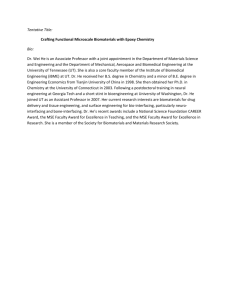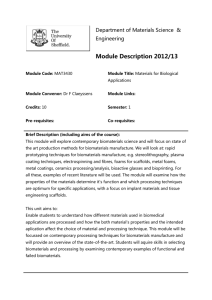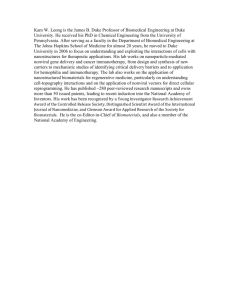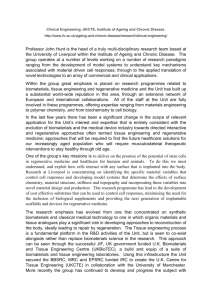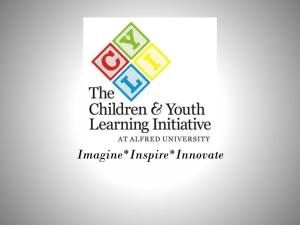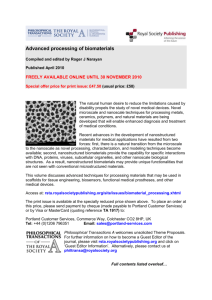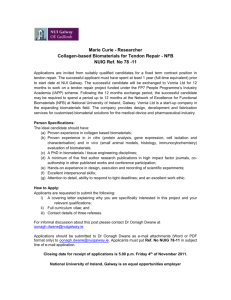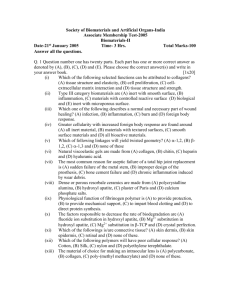ACS PowerPoint Template
advertisement
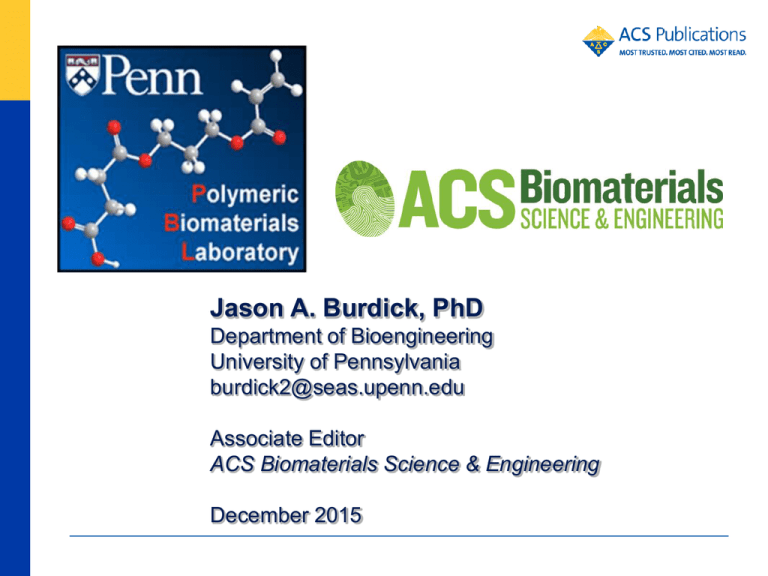
Jason A. Burdick, PhD Department of Bioengineering University of Pennsylvania burdick2@seas.upenn.edu Associate Editor ACS Biomaterials Science & Engineering December 2015 Associate Editors: Editor: David Kaplan Milica Radisic Jason Burdick Chris Holland University of Toronto University of Pennsylvania University of Sheffield 1st issue in January 2015 Check out the latest issues at pubs.acs.org/biomaterials Tufts University Accepting submissions in: • • • • Modeling and Synthesis of New Biomaterials Biomaterial Interfaces , Interactions, Health Risk Studies Regenerative Medicine Tissue Manufacturing and Technology • • • • Bioelectronics and BioMEMS Biomaterials Based Devices and Prosthetics Bioinspired and Biomimetic Approaches to Biomaterials Genetic Designs and Bioengineering Journal Vision: high quality publication to fill an important niche in the ACS portfolio for the biomaterials scientific community Key Goals: •reviewers that provide high quality input for authors •rapid review – short turnaround times •ACS support – no costs for publication, color; open access options…. Types of Contributions: •primary papers •communications •reviews •perspectives •special issues ACS editors are your peers American Chemical Society 3 A Bit More on Journal Scope: Modeling and informatics tools for biomaterials – scaling methods to guide biomaterial design, predictive algorithms for structure-function, biomaterial mechanics; integrating bioinformatics with biomaterials discovery, metabolomics in the context of biomaterials New biomaterials, bioinspired and biomimetic approaches to biomaterials – synthesis and chemical modifications, exploiting structural hierarchy and architectural control, combinatorial strategies for biomaterials discovery, new processing modes to purify and utilize natural polymers, biophysical regulation of cell functions, controlled and bioresponsive delivery of regulatory molecules, genetic biomaterials design, synthetic biology, new composite systems Biomaterial interfaces, biology and health - material-biology interactions, chemical/morphological/structural communication, signaling and biological responses, health risks, toxicology, safety, calcification, corrosion and degradation of biomaterials and devices, prosthetics Manufacturing, technology and tissues in the context of biomaterials – regenerative medicine, tissue engineering for basic and applied studies, organ-on-a-chip, bioreactor/perfusion systems, microdevices, 3D printing, inks, BioMEMS, optics and electronics interfaces with biomaterials, systems integration American Chemical Society 4 Questions: 1. How do Journals measure/evaluate the quality of a paper/decide to publish a paper? 2. Editorial decision making process. How does the process work and vary between different Journals? What is the goal of publishing? To share your high quality work with the right community, in a timely manner American Chemical Society 5 Pre-submission: Picking the right journal! • Is the scope appropriate? • Does it fit within recently published papers in the journal? • Is it the right level of impact and completeness? Some journals do a pre-submission inquiry • Formal versus informal • Ask your peers American Chemical Society 6 Post-submission: Step 1: Brief review by the main Editor • Outcomes: Rejected right away or sent to Associate Editor • Usually rejected because it is out of scope • Very poor writing, figures • Cover letter? Step 2: Reviewed by Associate Editor • Outcomes: Rejected editorially or sent to review • • • • • Rejected due to concerns of novelty, completeness, scope Similar to papers you have published recently? (e.g., title similar) Missing experiments, thorough? (e.g., animal study) Extremely poor grammar, writing Quality of figures, including stats, etc. • Editor may not be an expert, but this is who you need to convince American Chemical Society 7 Step 3: Peer review • Outcomes: Accept, Minor revision, Major revision, Reject with resubmission recommended, Reject • Always provide reviewers, not just your friends • Usually getting reviewers to respond initially and then provide review is most time-consuming step • How long would it take to revise? • Rarely do all reviewers agree • Need to consider all reviewers American Chemical Society 8 Step 4: Revisions •Outcomes: Rarely another major revision, mostly accept, minor revision, reject •Sent back to reviewers versus editor decision? •Usually same reviewers, maybe new ones added •Be thorough in your response, avoid “left for future studies” •Respond to all comments clearly, use evidence and references •Change the paper – don’t just respond to the reviewer Step 5?: Appeal • Of course you disagree with the reviewers (especially the 3rd one!) • Some journals have formal appeal process, but must have clear reasoning or evidence to support appeal • Be realistic American Chemical Society 9 Modified from: ‘8 reasons I accepted your article’ By Elizabeth Zwaaf January, 2013 1. It provides insight into an important issue. 2. The insight is useful to others. 3. The insight is used to develop a framework or theory, either a new theory or advancing an existing one. 4. The insight stimulates new, important questions. American Chemical Society 10 Modified from: ‘8 reasons I accepted your article’ By Elizabeth Zwaaf January, 2013 5. The methods used to explore the issue are appropriate (for example, data collection and analysis of data). 6. The methods used are applied rigorously and explain why and how the data support the conclusions. 7. Connections to prior work in the field or from other fields are made and serve to make the article's arguments clear. 8. The article tells a good story, meaning it is well written and easy to understand, the arguments are logical and not internally contradictory. American Chemical Society 11 Scope and Fit with Journal Quality of Content Major Points Novelty vs. Incremental American Chemical Society Conclusions Match Results 12 Good Luck! American Chemical Society 13
